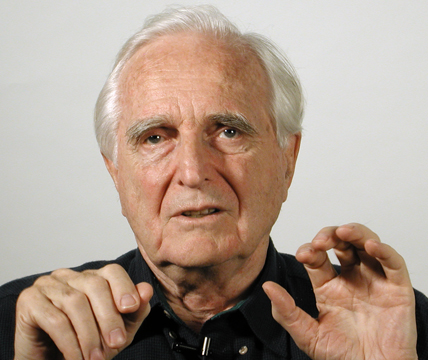 If you’re reading this, take a moment to thank Doug Engelbart. At a time when computers were big, expensive, isolated, finicky, and terribly difficult to program and use, this unassuming genius had a vision of a digital future that was so far ahead of its time that few of his peers took it seriously. He is widely credited with inventing the mouse, but that’s just a tiny part of his grand vision. Graphical user interfaces, interactive computing, the Internet, and more, owe their existence at least in part to Engelbart’s visionary work. Thank you, Doug.
If you’re reading this, take a moment to thank Doug Engelbart. At a time when computers were big, expensive, isolated, finicky, and terribly difficult to program and use, this unassuming genius had a vision of a digital future that was so far ahead of its time that few of his peers took it seriously. He is widely credited with inventing the mouse, but that’s just a tiny part of his grand vision. Graphical user interfaces, interactive computing, the Internet, and more, owe their existence at least in part to Engelbart’s visionary work. Thank you, Doug.
http://www.nytimes.com/2013/07/04/technology/douglas-c-engelbart-inventor-of-the-computer-mouse-dies-at-88.html?pagewanted=1&_r=1&smid=tw-share
Category: Chapter 5 Productivity Applications
 If you misspell a word in a paper or use the wrong font in a presentation, your error may be embarrassing. If you use the wrong formula in a spreadsheet, your error might be devastating. According to a recent study, the typical spreadsheet is riddled with math errors. This short Market Watch article should serve as a wake-up call to scientists, engineers, business people, students and others who do high-consequence work with numbers.
If you misspell a word in a paper or use the wrong font in a presentation, your error may be embarrassing. If you use the wrong formula in a spreadsheet, your error might be devastating. According to a recent study, the typical spreadsheet is riddled with math errors. This short Market Watch article should serve as a wake-up call to scientists, engineers, business people, students and others who do high-consequence work with numbers.
marketwatch.com/Story/story/print?guid=DB151EDA-A776-11E2-A57C-002128040CF6
Just as the mouse made the command-line interface of early PCs seem primitive, the touch screen may soon put the mouse out of a job. But after you see this short video, you may think that even the touch screen is old-fashioned. Once again, science fiction points the way to future technology.
wired.com/gadgetlab/2013/01/leap-motion-asus
The balance of power is shifting westward in the high-stakes competition for the most powerful computer in the world. The latest US champ is based in part on technology pioneered in the gaming industry. Like most supercomputers, this one will be used to produce ever-more-accurate simulations for scientific research and engineering applications.
money.cnn.com/2012/10/29/technology/innovation/titan-supercomputer/
With the vast amount of information available on the internet, it’s possible to create data mashups to support any trend, real or imagined. These tongue-in-cheek examples use real data to “prove” bogus relationships.
i.imgur.com/PedqQ.jpg
Computers generally sense human movements by seeing or feeling it. But this Microsoft research project suggests that your devices may soon be able to hear your gestures through ultrasonic waves.
mashable.com/2012/05/07/gesture-control-system-sound/
Will Your Glasses Be Smarter than You?
Project Glass
The brave new world of augmented reality may be closer than you think. If it becomes a popular product, Google’s Project Glass may make touch-screen smart phones seem positively old-fashioned. This Huffington Post article describes this intriguing wearable technology, and the video gives you a sense of what it might feel like to spend time behind the lenses of smart glasses.
NPR.org/2011/12/26/144146395/the-touchy-feely-future-of-technology
A few years ago touch-screen devices were novelties; today they’re everywhere. Hundreds of millions of smart phones and tablets are profoundly changing the ways people interact with tools, the Internet, and each other. This excellent NPR report covers the evolution of touch technology. Segments examine unusual uses, social implications, and future applications of this rapidly-changing technology. The site includes both text and audio versions of the story.
In this five-minute TED talk, Ian Ritchie gives one of the best short answers to this question we’ve seen. At the same time, he confesses to making a multi-million dollar misjudgment. Fascinating and fun.
[ted id=1244]
Facebook, Twitter, and other social media are overflowing with stories of real people living real lives. Or are they? This thought-provoking article by Paul Ford takes a hard look at what’s missing in the stories people tell through social media. This is one of the best pieces we’ve seen on the changing roles of social media and traditional journalism.